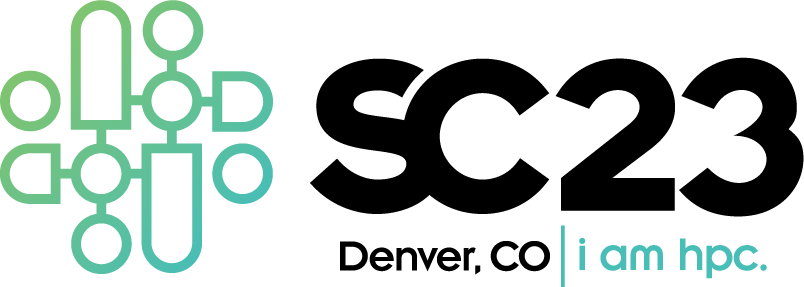The International Conference for High Performance Computing, Networking, Storage, and Analysis • Nov 12–17, 2023 • Denver, CO
The SC Conference Series serves as a testing ground for the latest advancements in high-performance networking, computing, storage, and analysis. Within this domain, the Network Research Exhibition (NRE) demonstrations harness the cutting-edge capabilities of SCinet, the dedicated high-capacity network of SC. Moreover, a curated group of NRE participants is annually welcomed to present their demo and experiment outcomes from the prior year’s conference in the Innovating the Network for Data-Intensive Science (INDIS) Workshop. In the current year, the AmLight infrastructure played a pivotal role by hosting several Network Research Exhibitions, bolstering high-performance showcases for Research and Educational Networks (RENs).
NRE-019
AmLight 2.0: Flexible control, deep visibility, and programmability @ Tbps!
Location: Caltech Booth (1255) & SCinet Theater (1275)
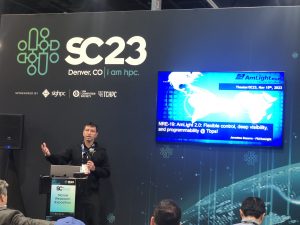 AmLight employs a hybrid network approach, combining optical spectrum and leased capacity to establish a cutting-edge and reliable network infrastructure dedicated to research and education. This network is vital for facilitating high-performance connectivity crucial to international collaborations in science, engineering, and education, particularly involving the National Science Foundation (NSF) research community. In 2023, AmLight rolled out its custom Software-Defined Networking (SDN) fabric, enabling network experimentation with P4 and flexible forwarding pipelines. This innovation, supported by the new SDN controller Kytos-ng, boasts more than 24 long-haul 100G links connecting key sites across the U.S., Latin America, and South Africa. AmLight’s SDN architecture, utilizing Edgecore Tofino 1 and Tofino 2, offers benefits like In-band Network Telemetry (INT) support and a flexible approach to pathfinding, finely tuned for traffic engineering support.
AmLight employs a hybrid network approach, combining optical spectrum and leased capacity to establish a cutting-edge and reliable network infrastructure dedicated to research and education. This network is vital for facilitating high-performance connectivity crucial to international collaborations in science, engineering, and education, particularly involving the National Science Foundation (NSF) research community. In 2023, AmLight rolled out its custom Software-Defined Networking (SDN) fabric, enabling network experimentation with P4 and flexible forwarding pipelines. This innovation, supported by the new SDN controller Kytos-ng, boasts more than 24 long-haul 100G links connecting key sites across the U.S., Latin America, and South Africa. AmLight’s SDN architecture, utilizing Edgecore Tofino 1 and Tofino 2, offers benefits like In-band Network Telemetry (INT) support and a flexible approach to pathfinding, finely tuned for traffic engineering support.
NRE-013
Turbocharging 100G Link: A High-Speed Data Filling Demo from South Africa to Denver!
Location: Caltech Booth (1255) & SCinet Theater (1275)
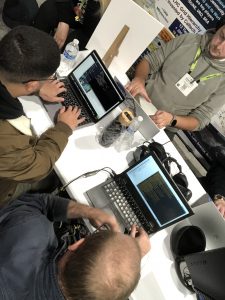 The AmLight network employs a hybrid strategy, combining optical spectrum and leased capacity to create a cutting-edge and dependable infrastructure supporting high-performance connectivity crucial for global science and engineering collaborations, especially with the NSF research community. The South African National Research Network (SANReN) group is instrumental in acquiring and implementing national and international capacity, aligning with the government’s cyberinfrastructure vision to enhance South African researchers’ global participation. Managed by CSIR’s Next Generation Enterprises and Institutions cluster, SANReN is a pivotal element of the National Integrated Cyberinfrastructure System (NICIS). The Tertiary Education and Research Network of South Africa (TENET) secures Internet and IT services for South African universities. The partnership with SANReN/TENET offers a unique opportunity to enhance AmLight-ExP’s 100G link using DTNs, and to monitor the link’s performance via diverse experiments. The demo aims to showcase the potential of the AmLight-SACS 100G link, fostering stronger collaborations between South Africa and the United States, while also exploring integration with CHPC and SANReN/TENET within the network of NRENs.
The AmLight network employs a hybrid strategy, combining optical spectrum and leased capacity to create a cutting-edge and dependable infrastructure supporting high-performance connectivity crucial for global science and engineering collaborations, especially with the NSF research community. The South African National Research Network (SANReN) group is instrumental in acquiring and implementing national and international capacity, aligning with the government’s cyberinfrastructure vision to enhance South African researchers’ global participation. Managed by CSIR’s Next Generation Enterprises and Institutions cluster, SANReN is a pivotal element of the National Integrated Cyberinfrastructure System (NICIS). The Tertiary Education and Research Network of South Africa (TENET) secures Internet and IT services for South African universities. The partnership with SANReN/TENET offers a unique opportunity to enhance AmLight-ExP’s 100G link using DTNs, and to monitor the link’s performance via diverse experiments. The demo aims to showcase the potential of the AmLight-SACS 100G link, fostering stronger collaborations between South Africa and the United States, while also exploring integration with CHPC and SANReN/TENET within the network of NRENs.
NRE-020
Global P4 Lab
Location: SCinet Theater (1275)
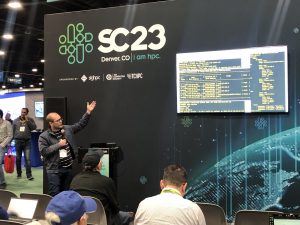 GP4L (Global P4 Lab) is a global overlay network composed of 100G/400G programmable switches from the GNA-G AutoGOLE / SENSE Persistent Multi-Resource Testbed and the GÉANT P4 Lab. The GP4L uses SONiC and RARE/FreeRtr, which are full-featured open-source network operating systems (NOSes), that at the same time implement traditional networking protocols and can be extended to integrate next-generation features as an opt-in strategy. GP4L provides the means to implement production-oriented feature experimentations and protocols, without impacting the rest of the network. This showcase will include demonstrations of newly deployed sites and interconnections with other testbeds like FABRIC and BRIDGES, Digital Twin capabilities, automated generation of real-time world map topology, and also support other NREs that are experimenting with at-scale advanced/novel networking protocols and use cases, like PolKA (Polynomial Key-based Architecture): a stateless source routing protocol based on arithmetic operations over a polynomial encoded route label. Also supported was IPv6 Flow Label Packet Marking initiative from WLCG, called SciTags.
GP4L (Global P4 Lab) is a global overlay network composed of 100G/400G programmable switches from the GNA-G AutoGOLE / SENSE Persistent Multi-Resource Testbed and the GÉANT P4 Lab. The GP4L uses SONiC and RARE/FreeRtr, which are full-featured open-source network operating systems (NOSes), that at the same time implement traditional networking protocols and can be extended to integrate next-generation features as an opt-in strategy. GP4L provides the means to implement production-oriented feature experimentations and protocols, without impacting the rest of the network. This showcase will include demonstrations of newly deployed sites and interconnections with other testbeds like FABRIC and BRIDGES, Digital Twin capabilities, automated generation of real-time world map topology, and also support other NREs that are experimenting with at-scale advanced/novel networking protocols and use cases, like PolKA (Polynomial Key-based Architecture): a stateless source routing protocol based on arithmetic operations over a polynomial encoded route label. Also supported was IPv6 Flow Label Packet Marking initiative from WLCG, called SciTags.
NRE-013
The Global Network Advancement Group: A Next Generation System for Data Intensive Sciences
Location: Caltech Booth (1255) & SCinet Theater (1275)
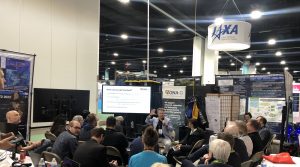 The Global Network Advancement Group, along with its Data Intensive Sciences and SENSE/AutoGOLE Working Groups, is collaborating globally to create a cutting-edge, integrated network system to address the challenges of exabyte and terabit/sec workflows, crucial for various scientific domains including high energy and astrophysics, bioinformatics, and data-intensive sciences. This initiative, known as the network research exhibition (NRE), showcased and demonstrated key aspects of this next-generation system, highlighting its potential to revolutionize research and education network operations. The NRE teams were focused on developing a dynamic, adaptive, programmable software-driven system that treats worldwide networks as a top-tier resource, seamlessly integrating them with computing and storage across diverse domains, ultimately optimizing network resources and streamlining workflows.
The Global Network Advancement Group, along with its Data Intensive Sciences and SENSE/AutoGOLE Working Groups, is collaborating globally to create a cutting-edge, integrated network system to address the challenges of exabyte and terabit/sec workflows, crucial for various scientific domains including high energy and astrophysics, bioinformatics, and data-intensive sciences. This initiative, known as the network research exhibition (NRE), showcased and demonstrated key aspects of this next-generation system, highlighting its potential to revolutionize research and education network operations. The NRE teams were focused on developing a dynamic, adaptive, programmable software-driven system that treats worldwide networks as a top-tier resource, seamlessly integrating them with computing and storage across diverse domains, ultimately optimizing network resources and streamlining workflows.
NRE-014
AutoGOLE/SENSE: End-to-End Network Services and Workflow Integration
Location:
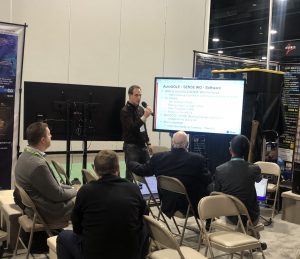 The AutoGOLE/SENSE and Data Intensive Sciences working groups within the Global Network Advancement Group represent a global collaboration involving R&E network operators, system developers, software developers, and scientists from various disciplines. The AutoGOLE/SENSE infrastructure offers multiple provisioning options, including OpenNSA, SURF ultimate Provider Agent (SuPA), MEICAN, and SENSE, which integrates network and end-system resources into a unified provisioning environment. The demonstration showcased how domain science applications can seamlessly integrate these services into their workflows through API-driven information discovery and service provisioning. The infrastructure enabled intercontinental data flows across high-performance R&E networks with DTN-based endpoints, depicted in the diagram above. At the campus level, connectivity beyond 100G was demonstrated at Caltech, UCSD, and Berkeley Lab (LBL), supported by CENIC and Ciena Waveserver Ais at Caltech and Los Angeles.
The AutoGOLE/SENSE and Data Intensive Sciences working groups within the Global Network Advancement Group represent a global collaboration involving R&E network operators, system developers, software developers, and scientists from various disciplines. The AutoGOLE/SENSE infrastructure offers multiple provisioning options, including OpenNSA, SURF ultimate Provider Agent (SuPA), MEICAN, and SENSE, which integrates network and end-system resources into a unified provisioning environment. The demonstration showcased how domain science applications can seamlessly integrate these services into their workflows through API-driven information discovery and service provisioning. The infrastructure enabled intercontinental data flows across high-performance R&E networks with DTN-based endpoints, depicted in the diagram above. At the campus level, connectivity beyond 100G was demonstrated at Caltech, UCSD, and Berkeley Lab (LBL), supported by CENIC and Ciena Waveserver Ais at Caltech and Los Angeles.
